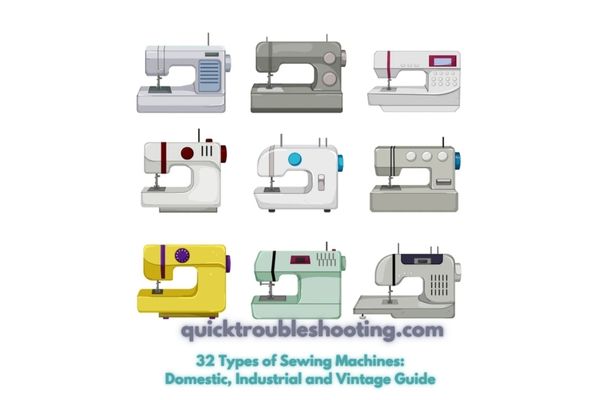32 Types of Sewing Machines: Domestic, Industrial and Vintage Guide
Curious about the diverse world of sewing machines and eager to explore the myriad options available? If you’ve ever wondered, “What types of sewing machines are there?” look no further.
Sewing machines come in various forms, primarily categorized as domestic machines tailored for home use and industrial machines geared towards factories and mass production of clothing. Within the realm of domestic machines, six distinct types cater to different needs, while the industrial category boasts a plethora of specialized machines.
Delving into the intricacies of sewing machines, this article serves as your comprehensive guide to navigating through the options and selecting the perfect machine for your sewing endeavors.
From the basics to the specialized, we’ll unravel the nuances of each type, empowering you to make an informed choice for your unique sewing projects. Let’s embark on a journey to uncover the 32 types of sewing machines, embracing both the familiar comfort of home sewing and the efficiency of industrial prowess.
Different Types of Sewing Machines
The world of sewing machines is rich and diverse, offering a spectrum of options that cater to various needs and skill levels. From the intricate artistry of embroidery to the efficiency demanded by industrial-scale operations, the realm of sewing machines has evolved significantly, revolutionizing the textile and garment industries.
In this section, we embark on a journey to explore the different types of sewing machines, delving into their unique features, functionalities, and the specific purposes they serve. Whether you’re a casual hobbyist seeking a reliable domestic machine or an industry professional in pursuit of specialized equipment, understanding the nuances of these sewing marvels is key to selecting the perfect tool for your unique stitching ventures.
Join us as we unravel the intricacies of different sewing machine types, providing insights that empower you to make informed choices tailored to your sewing aspirations.
Types of Sewing Machines: Domestic
Crafted specifically for household use, domestic sewing machines, as their name suggests, stand out as the preferred choice for home-based sewing. Although the quality and lifespan of these typical sewing machines may differ, they are not typically engineered for prolonged daily use.
Here is List of Types of Domestic Sewing Machines:
- Mechanical Sewing Machines
- Electronic Machines
- Computerized Or Automated Machines
- Embroidery Machines
- Quilting Machines
- Overlocking Or Serger Machines
- Heavy-Duty Sewing Machines
- Mini And Portable Machines
Characterized by their lightweight design, these machines are easily transportable and boast versatility, accommodating various stitches and sewing purposes.
1. Mechanical Sewing Machines
Description:
- Mechanical sewing machines are the most traditional type, featuring a simple design.
- They are operated manually using a handwheel to control the needle and a foot pedal to control the stitching speed.
Suitability:
- Ideal for beginners as they are straightforward and easy to understand.
- Well-suited for general sewing tasks such as garment construction, mending, and basic alterations.
Features:
- Basic stitch options such as straight stitch and zig-zag.
- Limited decorative stitches compared to electronic or computerized machines.
- Durable and requires minimal maintenance.
2. Electronic Sewing Machines
Description:
- Electronic sewing machines incorporate electronic components to enhance functionality.
- They maintain manual control but integrate electronic features for added convenience.
Features:
- Automatic buttonholing: The machine can automatically create buttonholes with precision.
- Stitch selection: Allows for easy selection of different stitches through electronic controls.
- Digital display: Some models come with a digital screen providing information about the selected stitch.
Suitability:
- Suitable for sewers who want additional features without the complexity of computerized machines.
- Intermediate level users looking to expand their sewing capabilities.
3. Computerized Sewing Machines
Description:
- Computerized sewing machines are technologically advanced, featuring built-in computer systems.
- They offer a wide array of automated functions for increased efficiency and precision.
Features:
- Extensive stitch options: A large variety of stitches, including decorative and specialty stitches.
- Embroidery options: Some models have embroidery capabilities for intricate designs.
- Programmable patterns: Users can create and save custom stitching patterns.
- Touchscreen interface: Often equipped with a touchscreen for easy navigation and customization.
Suitability:
- Best suited for advanced sewers and those involved in complex projects.
- Ideal for those who want the convenience of automated features.
4. Embroidery Machines
Description:
- Specialized machines designed specifically for intricate embroidery work.
- Often equipped with features tailored for embellishing fabrics with decorative designs.
Features:
- Hoop system: Typically includes a hoop to secure the fabric during embroidery.
- Computerized embroidery: Allows for precise and automated embroidery patterns.
- Multiple thread colors: Capable of using multiple thread colors for vibrant designs.
Suitability:
- Tailored for individuals who focus on embroidery projects.
- Ideal for adding detailed and artistic embellishments to fabrics.
5. Quilting Machines
Description:
- Quilting machines are specialized for quilting projects, which involve stitching through multiple layers of fabric.
Features:
- Larger throat space: Often equipped with a larger working area to accommodate quilts.
- Walking feet: Specialized presser feet to ensure even feeding of fabric layers.
- Stitch options: Includes stitches suitable for quilting patterns.
Suitability:
- Perfect for quilters and those who enjoy creating quilted items.
- Provides the necessary features for handling the unique demands of quilting.
6. Serger (Overlock) Machines
Description:
- Overlock machines, commonly known as sergers, are designed for finishing edges and seams.
Features:
- Trimming and stitching: Simultaneously trims excess fabric while stitching, preventing fraying.
- Multiple threads: Uses multiple threads to create a strong and secure seam.
Suitability:
- Essential for those who want professional-looking finished edges on garments.
- Commonly used in garment factories for mass production.
7. Heavy-Duty Sewing Machines
Description:
- Heavy-duty sewing machines are built with a robust design to handle thick fabrics and multiple layers.
Features:
- Powerful motor: Equipped with a strong motor for sewing through dense materials.
- Durable construction: Built to withstand the demands of sewing heavy fabrics like denim, canvas, and upholstery.
Suitability:
- Ideal for users who frequently work with challenging fabrics.
- Suitable for projects such as upholstery, bag making, and other heavy-duty sewing tasks.
8. Mini and Portable Sewing Machines:
Description:
- Mini and portable sewing machines are compact, lightweight, and designed for easy transport.
- They often have a small footprint, making them suitable for small spaces or on-the-go sewing.
Suitability:
- Ideal for individuals with limited space, such as small apartments or crafting on the go.
- Perfect for beginners who want a simple and portable machine for basic sewing projects.
- Commonly used for quick repairs, alterations, or small crafting projects.
Features:
- Compact size: These machines are smaller than traditional sewing machines, making them easy to carry and store.
- Portable: Designed for travel and on-the-go sewing, some models may even run on batteries.
- Limited stitch options: Due to their size, mini machines may offer basic stitch options suitable for simple sewing tasks.
- User-friendly: Typically straightforward in design, making them suitable for beginners.
Table of Types of Domestic Sewing Machines
| Type | Function and Features | Purpose | Cost Range |
|---|---|---|---|
| Mechanical Sewing Machines | – Simple design operated manually with a handwheel and foot pedal. – Ideal for beginners and general sewing tasks. – Basic stitch options. – Durable and low maintenance. | – Suitable for general sewing tasks, mending, and basic alterations. | $$ |
| Electronic Sewing Machines | – Incorporates electronic components. – Automatic buttonholing. – Stitch selection through electronic controls. – May have a digital display. | – Additional features without the complexity of computerized machines. – Intermediate level users. | $$$ |
| Computerized Sewing Machines | – Advanced with built-in computer systems. – Extensive stitch options. – Embroidery capabilities. – Programmable patterns. – Touchscreen interface. | – Best suited for advanced sewers and complex projects. – Convenient automation features. | $$$$ |
| Embroidery Machines | – Specialized for intricate embroidery work. – Hoop system for securing fabric. – Computerized embroidery. – Multiple thread colors. | – Tailored for embroidery projects. – Ideal for detailed and artistic embellishments. | $$$$ |
| Quilting Machines | – Specialized for quilting projects. – Larger throat space. – Walking feet for even stitching. – Stitch options suitable for quilting. | – Perfect for quilters and those creating quilted items. – Handles the demands of quilting. | $$$ |
| Serger (Overlock) Machines | – Designed for finishing edges and seams. – Trims and stitches simultaneously. – Uses multiple threads. | – Essential for professional-looking finished edges. – Common in garment factories. | $$ |
| Heavy-Duty Sewing Machines | – Robust design for thick fabrics and multiple layers. – Powerful motor. – Durable construction. | – Ideal for users working with challenging fabrics. – Suitable for heavy-duty tasks. | $$ |
| Mini and Portable Sewing Machines | – Compact size, lightweight, and designed for easy transport. – Portable with some models running on batteries. – Limited stitch options suitable for simple tasks. – User-friendly and straightforward in design. | – Ideal for individuals with limited space or crafting on the go. – Perfect for beginners and basic sewing projects. – Commonly used for quick repairs, alterations, or small crafting projects. | $ |
Types of Sewing Machines: Industrial
Industrial sewing machines stand as robust workhorses, designed to handle a diverse array of fabrics ranging from heavyweight materials to upholstery fabrics, leather, rubber, plastic, and canvas. Unlike their domestic counterparts, these machines are tailored for durability, capable of taking on tough materials in various projects. The industrial machine’s sturdiness has even led to their incorporation into home industries due to their hardworking and enduring nature.
Constructed with metal bodies and interiors, industrial machines prioritize mechanical functionality over computerized components, ensuring longevity and extended sewing capabilities. Many feature a flatbed design, with the sewing area set into a table, contributing to stability during operation.
While these specialized industrial sewing machines are more expensive than domestic counterparts, their second-hand market remains robust, attesting to their enduring value. Renowned manufacturers such as Juki and Singer produce excellent industrial sewing machines, known for their reliability and performance.
Operating an industrial sewing machine requires a bit more skill, akin to driving a truck compared to a car. The payoff, however, is in their remarkable performance. Noteworthy characteristics include their distinctive noise, a result of their faster pace and greater power. Controlling the foot pedal speed becomes essential for achieving precision and mastery.
Here is List of Types of Industrial Sewing Machines:
- Single Needle Lockstitch Machine
- Double Needle Lockstitch Machine
- Walking Foot Machine
- Overlock Machine
- Coverstitch Machine
- Back Tack Machine
- Buttonhole Machine
- Zig-Zag Machines
- Lock Stitch Machine
- Button Sewing Machine
- Leather Machines
- Chain Stitch Machine
- Blind Stitch Machine
- Safety Stitch Machines
- Cylinder Bed Sewing Machines
- Flat Bed Sewing Machines
Many industrial machines necessitate being inset or bolted to a table, connected to a foot pedal to minimize vibrations during operation.
Here are some common types of industrial sewing machines:
9. Single Needle Lockstitch Machine
- Function:
- Commonly used for straight stitching in garments and fabrics.
- Creates a strong and precise stitch, making it ideal for various materials.
- Purpose:
- Widely employed in garment manufacturing and other industries for basic stitching.
- Suitable for tasks such as seaming, topstitching, and edge stitching.
10. Double Needle Lockstitch Machine
- Function:
- Allows for parallel stitching or decorative stitching with two needles.
- Offers versatility in creating various stitch patterns.
- Purpose:
- Used for decorative stitching on garments, creating parallel lines, and enhancing aesthetics.
- Commonly employed in industries requiring intricate stitching details.
11. Walking Foot Machine
- Function:
- Features a walking foot mechanism to help feed multiple layers of fabric evenly.
- Prevents uneven feeding, making it suitable for quilting and heavy materials.
- Purpose:
- Ideal for tasks that involve sewing through multiple layers of fabric, leather, or upholstery.
- Commonly used in industries requiring precision in fabric alignment.
12. Overlock Machine
- Function:
- Used for finishing edges and seams quickly.
- Trims excess fabric while simultaneously stitching to prevent fraying.
- Purpose:
- Essential in garment factories for efficient and professional finishing.
- Suitable for tasks where durability and neatness of edges are critical.
13. Coverstitch Machine
- Function:
- Creates professional-looking hems and cover stitches.
- Suitable for hemming knit fabrics.
- Purpose:
- Often used in the production of knitwear, sportswear, and activewear.
- Provides a clean and stretchable finish, making it ideal for sewing jersey and other knitted fabrics.
14. Back Tack Machine
- Function:
- Specialized for reinforcing specific points on garments.
- Creates short, strong stitches at precise locations.
- Purpose:
- Used in the reinforcement of stress points such as pockets, belt loops, and buttonholes.
- Commonly found in industries where durability and reinforcement are crucial.
15. Buttonhole Machine
- Function:
- Automatically creates buttonholes with precision.
- Offers consistency and accuracy in buttonhole sewing.
- Purpose:
- Essential for high-volume production of garments with button closures.
- Ensures uniformity in buttonhole size and placement.
16. Zig-Zag Machines
Function:
- Zig-zag machines create a zig-zag stitch pattern, allowing for versatility in stitching.
- The zig-zag stitch is ideal for preventing fraying, reinforcing edges, and adding decorative details.
Purpose:
- Widely used for a variety of applications, including finishing seams, mending, and creating decorative stitches.
- Commonly employed in the production of stretch fabrics and garments where flexibility in stitching is essential.
17. Lock Stitch Machine
Function:
- Lock stitch machines create a strong, secure, and uniform stitch by interlocking the upper and lower threads.
- One of the most common and versatile stitch types in industrial sewing.
Purpose:
- Suitable for a wide range of fabrics and applications, including garment construction, upholstery, and accessories.
- Provides a neat and stable stitch, making it a fundamental machine in various industries.
18. Button Sewing Machine
Function:
- Button sewing machines are specialized for attaching buttons to garments and fabrics.
- They automate the process, ensuring precise and secure button placement.
Purpose:
- Essential in garment manufacturing for efficient and consistent button attachment.
- Increases production speed and accuracy in sewing buttons onto various materials.
19. Leather Machines
Function:
- Leather sewing machines are designed to handle the unique challenges of sewing leather and other heavy materials.
- Equipped with features like a powerful motor and specialized presser feet for handling thick fabrics.
Purpose:
- Commonly used in the production of leather goods such as bags, belts, and upholstery.
- Provides the strength and precision required for sewing through tough materials.
20. Chain Stitch Machine
Function:
- Chain stitch machines create a series of interconnecting loops, forming a chain-like stitch.
- Can be used for decorative purposes or for creating a strong, flexible seam.
Purpose:
- Suitable for applications where a stretchable and secure stitch is required, such as in the construction of activewear and sportswear.
- Used in various industries for both functional and decorative stitching.
21. Blind Stitch Machine
Function:
- Blind stitch machines create nearly invisible hems by sewing through a single layer of fabric.
- The stitching is hidden on one side of the fabric, providing a clean and professional finish.
Purpose:
- Commonly used in garment manufacturing for hemming skirts, trousers, and sleeves.
- Ideal for creating inconspicuous hems in clothing and home textiles.
22. Safety Stitch Machines
Function:
- Safety stitch machines create a strong and secure stitch that combines a chain stitch with an overlock stitch.
- Offers a durable and reinforced seam, preventing unraveling.
Purpose:
- Widely used in industries where the strength and durability of the seam are crucial, such as in workwear and heavy-duty applications.
- Provides an extra layer of security against seam breakage.
23. Cylinder Bed Sewing Machines
Function:
- Cylinder bed sewing machines have a cylindrical shape, allowing for sewing in cylindrical or tubular items.
- Ideal for stitching in tight or curved spaces that are challenging for flat-bed machines.
Purpose:
- Commonly used for sewing items like sleeves, cuffs, and other cylindrical parts of garments.
- Offers versatility in garment construction, especially when working with three-dimensional pieces.
24. Flat Bed Sewing Machines
Function:
- Flat bed sewing machines have a flat, rectangular-shaped bed for sewing flat pieces of fabric.
- Suitable for a wide range of sewing tasks, providing a stable surface for material support.
Purpose:
- Versatile and widely used in garment construction, quilting, and general sewing.
- The flat bed design accommodates various sewing projects, offering stability and ease of use.
Each type of industrial sewing machine has its unique functions and purposes, catering to specific needs in garment production, upholstery, and various other industries. The details provided offer insights into the capabilities and applications of these specialized machines.
Comparison Table of the Types of Sewing Machines ( Industrial Sewing Machines)
Here’s a table summarizing the information about each type of industrial sewing machine, including their function, purpose, and cost range:
| Type | Function | Purpose | Cost Range |
|---|---|---|---|
| Single Needle Lockstitch Machine | – Commonly used for straight stitching in garments and fabrics. | – Widely employed in garment manufacturing and other industries for basic stitching. | $$ – $$$ |
| Double Needle Lockstitch Machine | – Allows for parallel stitching or decorative stitching with two needles. | – Used for decorative stitching on garments, creating parallel lines, and enhancing aesthetics. | $$ – $$$ |
| Walking Foot Machine | – Features a walking foot mechanism to help feed multiple layers of fabric evenly. | – Ideal for tasks that involve sewing through multiple layers of fabric, leather, or upholstery. | $$ – $$$ |
| Overlock Machine | – Used for finishing edges and seams quickly. | – Essential in garment factories for efficient and professional finishing. Suitable for tasks where durability and neatness of edges are critical. | $$ – $$$ |
| Coverstitch Machine | – Creates professional-looking hems and cover stitches. | – Often used in the production of knitwear, sportswear, and activewear. Provides a clean and stretchable finish. | $$ – $$$ |
| Back Tack Machine | – Specialized for reinforcing specific points on garments. | – Used in the reinforcement of stress points such as pockets, belt loops, and buttonholes. Commonly found in industries where durability is crucial. | $$ – $$$ |
| Buttonhole Machine | – Automatically creates buttonholes with precision. | – Essential for high-volume production of garments with button closures. Ensures uniformity in buttonhole size and placement. | $$ – $$$ |
| Zig-Zag Machines | – Create a zig-zag stitch pattern, allowing for versatility in stitching. | – Widely used for a variety of applications, including finishing seams, mending, and creating decorative stitches. | $$ – $$$ |
| Lock Stitch Machine | – Creates a strong, secure, and uniform stitch by interlocking the upper and lower threads. | – Suitable for a wide range of fabrics and applications, including garment construction, upholstery, and accessories. | $$ – $$$ |
| Button Sewing Machine | – Specialized for attaching buttons to garments and fabrics. | – Essential in garment manufacturing for efficient and consistent button attachment. Increases production speed and accuracy. | $$ – $$$ |
| Leather Machines | – Designed to handle the unique challenges of sewing leather and other heavy materials. | – Commonly used in the production of leather goods such as bags, belts, and upholstery. Provides the strength and precision required for tough materials. | $$ – $$$ |
| Chain Stitch Machine | – Creates a series of interconnecting loops, forming a chain-like stitch. | – Suitable for applications where a stretchable and secure stitch is required, such as in the construction of activewear and sportswear. | $$ – $$$ |
| Blind Stitch Machine | – Creates nearly invisible hems by sewing through a single layer of fabric. | – Commonly used in garment manufacturing for hemming skirts, trousers, and sleeves. Ideal for creating inconspicuous hems in clothing and textiles. | $$ – $$$ |
| Safety Stitch Machines | – Creates a strong and secure stitch that combines a chain stitch with an overlock stitch. | – Widely used in industries where the strength and durability of the seam are crucial, such as in workwear and heavy-duty applications. | $$ – $$$ |
| Cylinder Bed Sewing Machines | – Have a cylindrical shape, allowing for sewing in cylindrical or tubular items. | – Commonly used for sewing items like sleeves, cuffs, and other cylindrical parts of garments. Offers versatility in garment construction. | $$ – $$$ |
| Flat Bed Sewing Machines | – Have a flat, rectangular-shaped bed for sewing flat pieces of fabric. | – Versatile and widely used in garment construction, quilting, and general sewing. The flat bed design accommodates various sewing projects. | $$ – $$$ |
Please note that the cost ranges provided are approximate and can vary based on factors such as brand, features, and additional accessories. The symbols $, $$, $$$ indicate the relative cost level, with $ being the lowest and $$$ being the highest.
Vintage Types Of Sewing Machines
Embracing a rich history and timeless craftsmanship, vintage sewing machines hold a unique allure, particularly those that have gracefully crossed the century mark, making them antique treasures.
- Singer Featherweight
- Singer 201
- Singer 66
- Singer 221
- White Rotary
- New Home Model No. 9
- Vintage Hand-Crank Machines
- Treadle Sewing Machines
Let’s delve into some distinguished categories of vintage sewing machines:
25. Singer Featherweight
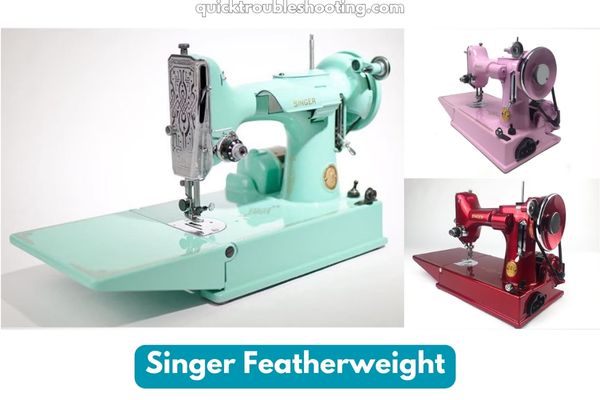
- Description:
- The Singer Featherweight is a compact and portable sewing machine produced by the Singer Manufacturing Company from the 1930s to the 1960s.
- Known for its small size, it became a favorite among quilters and those who needed a lightweight machine for on-the-go sewing.
- Features:
- Compact and lightweight design, making it easy to transport.
- Despite its small size, it maintains durability and functionality.
- Straight-stitch machine with basic features suitable for various sewing tasks.
- Legacy:
- Highly sought after by collectors and sewing enthusiasts due to its iconic design and historical significance.
- Despite its age, many Singer Featherweights continue to be operational and are prized for their reliability.
26. Singer 201
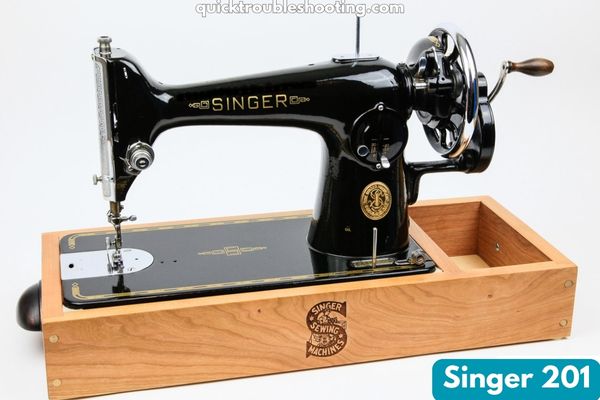
- Description:
- The Singer 201 is known for its all-metal construction and durability.
- Produced in the mid-20th century, it was considered a workhorse in many sewing rooms.
- Features:
- Sturdy all-metal frame and parts contribute to its longevity.
- Offers a variety of stitches, including straight and zig-zag, making it versatile for different sewing projects.
- Recognized for its smooth and quiet operation.
- Legacy:
- Regarded as a classic vintage sewing machine with a reputation for reliability and precision.
- Often chosen by sewers who appreciate the robust build and timeless design.
27. Singer 66
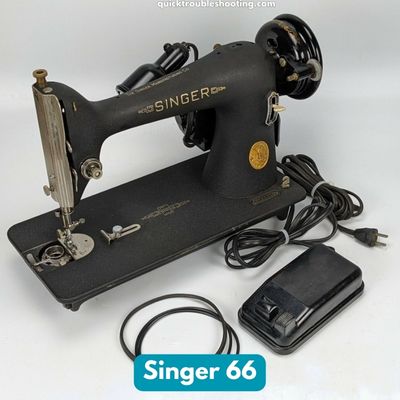
- Description:
- Popular in the early to mid-20th century, the Singer 66 is known for its smooth operation and solid build.
- It features an elegant and classic design that reflects the aesthetics of its time.
- Features:
- Straight-stitch machine with a powerful motor suitable for heavy fabrics.
- Treadle and electric versions were available, providing flexibility in usage.
- The machine is celebrated for its ability to handle both basic and heavy-duty sewing tasks.
- Legacy:
- Often considered a vintage workhorse due to its reliability and durability.
- Collectors appreciate its historic value and the craftsmanship of its design.
28. Singer 221 (Featherweight)
- Description:
- Also known as the “Featherweight,” the Singer 221 is a lightweight and highly sought-after vintage model.
- Introduced as a portable sewing machine, it gained popularity for its convenience and performance.
- Features:
- Weighing only about 11 pounds, it is one of the lightest sewing machines ever produced by Singer.
- Despite its compact size, it offers impressive stitch quality and reliability.
- Became iconic for its role in quilting circles and for being a favorite among traveling sewers.
- Legacy:
- Enjoys a cult following among sewing enthusiasts and collectors.
- Its portability and historical significance contribute to its desirability.
29. White Rotary
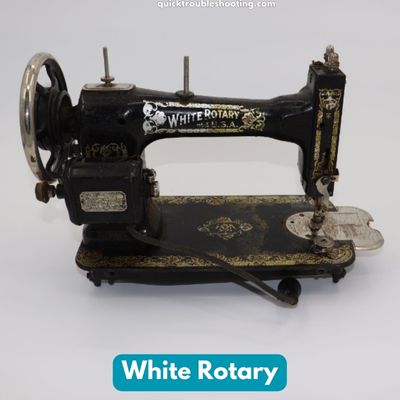
- Description:
- The White Rotary is a vintage sewing machine known for its unique rotary design.
- Produced by the White Sewing Machine Company, it has a distinctive appearance compared to other machines of its time.
- Features:
- The rotary mechanism contributes to a smooth and quiet operation.
- Available in various models, some with ornate decals and detailing.
- Provides basic straight stitching and zig-zag capabilities.
- Legacy:
- Recognized for its innovative design and durability.
- Collectors appreciate the variety of styles and models available in the White Rotary series.
30. New Home Model No. 9
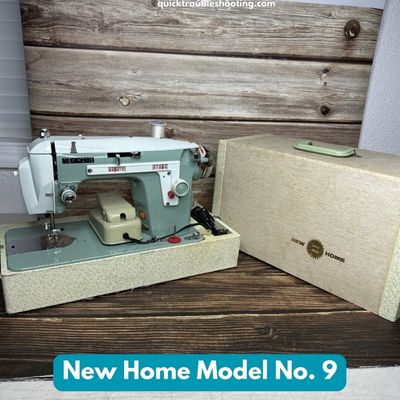
- Description:
- The New Home Model No. 9 is an ornate and decorative vintage sewing machine.
- Manufactured by the New Home Sewing Machine Company, it reflects the design aesthetics of its era.
- Features:
- Ornate and decorative detailing, often featuring floral decals and intricate designs.
- Offers basic stitching functions suitable for its time.
- Represents a blend of functionality and artistic craftsmanship.
- Legacy:
- Valued by collectors and vintage sewing machine enthusiasts for its artistic appeal.
- Considered a piece of functional art, showcasing the craftsmanship of the period.
31. Vintage Hand-Crank Machines
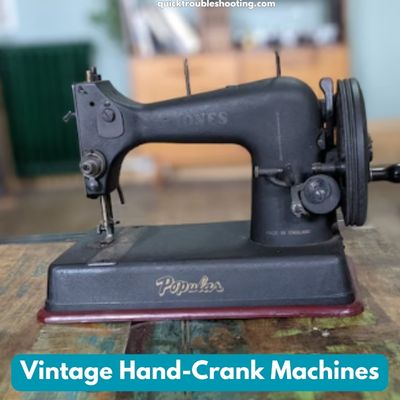
- Description:
- Vintage hand-crank machines are manual sewing machines operated by a hand crank, often without electricity.
- These machines were prevalent in the era before widespread electrification.
- Features:
- Operated by hand, requiring the user to turn a crank to power the machine.
- Simple mechanical design with fewer moving parts compared to electric machines.
- Offers basic straight stitching and may include attachments for different sewing techniques.
- Legacy:
- Represents an era when manual craftsmanship was integral to sewing.
- Collectors appreciate the simplicity and historical significance of these hand-crank machines.
31. Treadle Sewing Machines
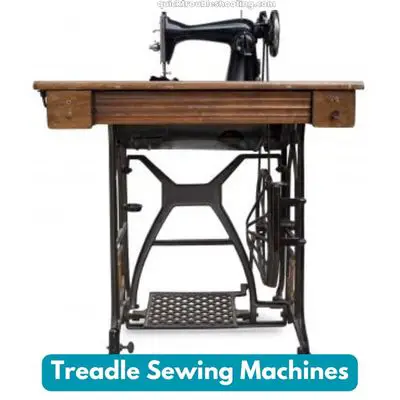
- Description:
- Treadle sewing machines are powered by a foot pedal, providing a rhythmic and manual way of sewing.
- These machines were widely used before electric sewing machines became commonplace.
- Features:
- The machine is operated by a foot treadle that drives the sewing mechanism.
- Offers a slower but steady pace of sewing, allowing for control and precision.
- Treadle machines were available in various styles and models to suit different preferences.
- Legacy:
- Reflects an era when manual dexterity and coordination were essential for sewing.
- Collectors appreciate treadle machines for their historical value and the craftsmanship involved in their production.
Each of these vintage sewing machines carries a unique charm, combining functionality with historical aesthetics. They showcase the evolution of sewing technology and design, and their continued popularity among collectors is a testament to their enduring appeal.
Comparison Table of the Types of Sewing Machines ( Vintage Sewing Machines)
| Type | Function | Purpose | Cost Range |
|---|---|---|---|
| Singer Featherweight | Compact and portable; Basic straight-stitching; Lightweight and durable design. | Ideal for on-the-go sewing, popular among quilters; Historical significance and iconic design. | $$ – $$$ |
| Singer 201 | All-metal construction; Variety of stitches; Smooth and quiet operation. | Regarded as a workhorse; Versatile for different projects; Appreciated for reliability and precision. | $$$ – $$$$ |
| Singer 66 | Straight-stitch with a powerful motor; Available in treadle and electric versions. | Vintage workhorse for basic and heavy-duty tasks; Classic design and durability. | $$ – $$$ |
| Singer 221 (Featherweight) | Lightweight (Featherweight); Compact size with impressive stitch quality. | Iconic for quilting; Portability and performance; Cult following among enthusiasts. | $$$ – $$$$$ |
| White Rotary | Unique rotary design; Smooth and quiet operation; Available in various models. | Recognized for innovation and durability; Collectors appreciate variety in design. | $$ – $$$ |
| New Home Model No. 9 | Ornate and decorative design; Basic stitching functions. | Valued for artistic appeal; Considered a functional art piece showcasing craftsmanship. | $$ – $$$ |
| Vintage Hand-Crank Machines | Manual operation with a hand crank; Simple mechanical design. | Represents an era of manual craftsmanship; Appreciated for simplicity and historical significance. | $ – $$ |
| Treadle Sewing Machines | Powered by a foot treadle; Offers a slower but steady pace of sewing. | Reflects an era of manual sewing; Collectors appreciate historical value and craftsmanship involved. | $ – $$ |
Note: The cost range is approximate and may vary based on factors such as machine condition, rarity, and collector’s demand.
Other Types of Sewing Machines
32. Toy Sewing Machine Types
Description: A delightful category in the world of sewing machines, toy sewing machines are enchanting, scaled-down replicas crafted specifically for children. Tailored to introduce young minds to the art of sewing, these miniature marvels boast additional safety features, making them a perfect blend of entertainment and education. Designed with simplicity in mind, they provide a stepping stone for budding seamstresses, offering a hands-on experience to learn basic sewing skills.
Functional Limitations: Toy sewing machines intentionally limit their range of functions to align with the skill levels and safety requirements of young users. Typically, these machines focus on executing a straight stitch, simplifying the learning process for children. Some variations may exclusively sew fabrics provided within the package, while others extend their capability to sew light cotton fabrics, providing a slightly broader creative scope.
Educational Value: Beyond mere playthings, toy sewing machines serve as educational tools, fostering creativity and nurturing a foundational understanding of sewing techniques. The hands-on experience with these miniature machines instills a sense of accomplishment in children, encouraging them to explore their creative instincts while developing an appreciation for the art of sewing.
In summary, toy sewing machines offer a whimsical avenue for young enthusiasts to embark on their sewing journey. These pint-sized companions not only prioritize safety but also lay the groundwork for valuable skills, making the learning process enjoyable and engaging for the next generation of sewing enthusiasts.
Types of Sewing Machines – Which Should You Choose?
When it comes to what type of sewing machine or cloth stitching machine to buy, it depends on the functions you will need, how often you plan to sew, and of course, your budget. For the majority of beginner sewers, you will be looking at either a cheaper computerized or simple electronic machine.
I have a Janome electronic machine with knobs that turn manually and no computerized functions. While it is a fairly basic machine, it is a workhorse that has lasted for years and can sew heavy materials and even leather.
The reality is that most people rarely use the decorative stitches that come with upmarket machines.
Comparison Table of the Types of Sewing Machines
Here is a table to help you decide what is the best type of sewing machine for you:
| Factor | Mechanical | Electronic | Computerized | Embroidery | Quilting | Serger | Heavy-Duty | Mini/Portable | Vintage |
|---|---|---|---|---|---|---|---|---|---|
| User Expertise | Beginner to Intermediate | Intermediate to Advanced | Intermediate to Advanced | Intermediate to Advanced | Intermediate to Advanced | Intermediate to Advanced | Intermediate to Advanced | Beginner to Intermediate | Intermediate to Advanced |
| Intended Use | General sewing tasks, mending | Versatile sewing tasks | Advanced projects, embroidery | Embroidery projects | Quilting projects | Finishing edges and seams | Thick fabrics, multiple layers | Simple tasks, on-the-go | Versatile sewing tasks |
| Budget | $ – $$ | $$ – $$$ | $$$ – $$$$ | $$ – $$$ | $$ – $$$ | $$ – $$$ | $$$ – $$$$ | $ – $$ | $$ – $$$ |
| Stitch Options | Basic stitches | Advanced stitch options | Extensive stitch options | Specialized for embroidery | Quilting-specific stitches | Overlocking stitches | Suitable for various stitches | Limited but functional | Varied stitches |
| Automation Features | Manual operation | Some automated features | Many automated features | Automatic embroidery functions | Limited automation | Automatic thread trimming, others | Limited automation | Manual operation, some features | Manual operation |
| Portability | Portable | Portable | Portable | Less portable | Less portable | Portable | Less portable | Very portable | Less portable |
| Durability | Durable | Durable | Durable | Moderate durability | Moderate durability | Durable | Very durable | Moderate durability | Durable |
| Versatility | Limited versatility | Versatile | Highly versatile | Limited versatility | Versatile | Limited versatility | Limited versatility | Limited versatility | Versatile |
This table provides a quick overview of the key factors to consider when choosing a sewing machine type based on user needs. Users can assess their priorities in terms of expertise, intended use, budget, and desired features to make an informed decision.
FAQ
What Are Computerized Sewing Machines, and Are They Suitable for Beginners?
Computerized sewing machines are advanced models equipped with built-in computer systems. They offer extensive stitch options, embroidery capabilities, and often feature a touchscreen interface. While these machines provide powerful automation, they might be overwhelming for beginners. However, some computerized machines cater to beginners by offering a balance of automation and user-friendly controls.
Are Heavy-Duty Sewing Machines Only for Professional Seamstresses?
Heavy-duty sewing machines are designed for robust tasks, such as working with thick fabrics and multiple layers. While professionals often use them, they’re not exclusive to experts. Hobbyists and home sewers working on challenging projects, like denim or upholstery, can benefit from heavy-duty machines. These machines are user-friendly and suitable for anyone dealing with demanding sewing tasks.
How Do Serger (Overlock) Machines Differ From Standard Sewing Machines?
Serger machines, or overlock machines, specialize in finishing edges and seams. Unlike standard sewing machines, sergers trim and stitch simultaneously, preventing fabric fraying. They use multiple threads to create a professional finish. While not a replacement for a regular sewing machine, sergers complement them by providing a neat edge suitable for garments and other fabric items.
Can Mini and Portable Sewing Machines Handle Everyday Sewing Tasks?
Mini and portable sewing machines are ideal for everyday tasks such as quick repairs, alterations, or small crafting projects. While they may have limited stitch options, their compact size and portability make them convenient for individuals with limited space or those who need an on-the-go sewing solution. They are beginner-friendly and suitable for basic sewing needs.
What Features Should I Look for in a Quilting Machine?
A quilting machine should have a larger throat space, walking feet for even stitching, and stitch options suitable for quilting. Additionally, it should offer features like adjustable speed control and quilting-specific accessories. Look for a machine that balances precision and power to cater to the unique demands of quilting projects, making the quilting process more efficient and enjoyable.
What Is The Most Common Type Of Sewing Machine?
The most common type of sewing machine is the Mechanical Sewing Machine. These machines are straightforward, user-friendly, and operated manually. They are often recommended for beginners due to their simplicity and ease of use. Mechanical sewing machines are suitable for general sewing tasks, mending, and basic alterations.
What Type Of Sewing Machine Is Best For Beginners?
The best type of sewing machine for beginners is generally a Mechanical Sewing Machine. These machines offer basic features, a simple design, and are manually operated, making them ideal for individuals who are just starting their sewing journey. Mechanical sewing machines help beginners grasp fundamental sewing techniques before moving on to more advanced models with electronic or computerized features.
Conclusion: Types of Sewing Machines
In conclusion, the diverse world of sewing machines offers a range of options to suit various needs and skill levels. Whether you’re a seasoned professional or a beginner just starting, there’s a sewing machine tailored to your requirements. From the simplicity of mechanical machines to the advanced features of computerized models, each type serves a unique purpose.
The decision-making process should consider factors such as the intended use, desired features, and personal skill level. As technology continues to advance, sewing machines evolve, providing users with an array of choices to explore their creativity and accomplish sewing projects with efficiency and precision. Happy stitching!
